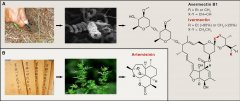Hongjuan Wei,Zhenjian Lin,Dehai Li,Qianqun Gu,Tianjiao Zhu,
关键词:一株菌多种次级代谢产物(One,strain,many,compounds,OSMAC),微生物次级代谢产物,混合培养,基因组扫描
摘要:微生物次级代谢产物的结构多样性赋予其广泛的生物活性,是药物先导化合物的重要来源。然而传统单一的培养方法,使微生物中大量的代谢途径不能被表达,以至于许多代谢产物不能产生。因此,运用各种技术和方法激活这些沉默途径,获得结构多样的代谢产物已成为目前关注的热点。一株菌多种次级代谢产物(One strain many compounds, OSMAC)策略作为一种简便有效的研究手段,已成功应用于该领域的研究。本文综述了OSMAC策略中常用的研究手段(包括改变培养状态、混合培养及添加酶抑制剂等),以及OSMAC与基因组扫描技术相结合的研究进展,并介绍了本研究室利用此方法对高产细胞松弛素的海洋来源真菌曲丽穗霉(Spicaria elegans KLA03)进行研究的部分结果。

遗传, 2018, 40(10): 874-887 doi: 10.16288/j.yczz.18-169 综述 中国丝状真菌次级代谢分子调控研究进展 潘园园,1, 刘钢,1,2 1. 中国科学院微生物研究所,真...

Self-Fueled Biomimetic Liquid Metal Mollusk Authors Jie Zhang, Youyou Yao, Lei Sheng, Jing Liu Abstract A liquid metal motor that can eat aluminum food and then move spontaneously a...

Ben Shen DOI: http://dx.doi.org/10.1016/j.cell.2015.11.031 The 2015 Nobel Prize in Physiology or Medicine has been awarded to William C. Campbell, Satoshi Omura, and Youyou Tu for t...

Xiangtao Meng a , b , Kevin J. Edgar a , b , , a Macromolecules and Interfaces Institute, Virginia Tech, Blacksburg, VA 24061, United States b Department of Sustainable Biomaterials...